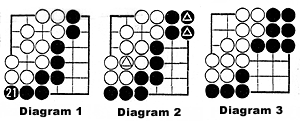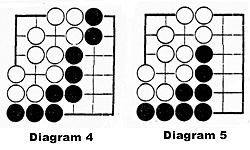Fujitsu Cup
The first two rounds of the 12th Fujitsu Cup, jointly sponsored by computer maker Fujitsu Ltd. and The Yomiuri Shimbun, were held on April 10 and 12 at the headquarters of the Japan Go Association in Tokyo. This is the first international tournament to bill itself as a world go championship. In the first five years, the Japanese dominated this tournament, but then South Korean players won four cups, and Japanese and Chinese players won one each since then.In this year's tournament, Japan and South Korea both fielded seven players and China six. Taiwan, Europe, North America and South America each had one representative.
The most noteworthy victory in the first round was when North American representative Jimmy Cha defeated Shinzo Ishii, 9-dan, of Japan. Cha was born in South Korea where he studied to be a professional player. He reached 4-dan in 1984, the year he emigrated to the United States. This is his sixth appearance in the tournament. Although he has never made it past the quarterfinals, he has defeated a number of strong players over the years. His most notable win was against Cho Chikun in 1990. He lost to Yoshio Ishida in the second round. Ishida lived up to his nickname of "computer" by playing a subtle endgame sequence that allowed Ishida to win by 51/2 points.
In the second round, when the seeded players joined the tournament, two big upsets occurred. Last year's champion, Lee Chang Ho, lost to Masao Kato, and last year's runner-up, Chang Hao, went down to defeat at the hands of Lee Sang Jae, a 21-year-old rising star from South Korea who is Cho Chikun's nephew.
Cho Chikun's game against Wang Lei from China was undoubtedly the most incredible of the tournament so far. Cho lost a large group and his position looked hopeless. But Cho simultaneously attacked two of Wang's groups and managed to kill one of them.
One player to watch in this tournament is Qui Jun, a 4-dan from China. Last September, he won the 1998 Chinese Go Championship. At 16, he is the youngest player to have ever won a major title in China. His go is brilliant and original. It features sharp tactics and he is not afraid to take chances. For this reason, his games always create a sensation. He has won a place in the quarterfinals by defeating Taiwan representative Chou Chun-hsu.
The Fujitsu Cup is a five-round knockout tournament, with a playoff for third place. All games are played with Black giving White 51/2 points in compensation for moving first. This extra half point ensures that draws will not occur. Each player is given a time allowance of three hours, but when a player reaches the final 10 minutes of his time allowance "byo yomi" begins. This means that if he makes his move within one minute, no time is deducted from his allowance. If he takes more than one minute, then a minute is deducted from his remaining time. If a player exceeds his final 10 minutes, then he loses on time.
The players who took the first three places in the previous year's tournament are seeded into the second round. Five other players from countries with top results in the previous year's tournament are also seeded into the second round.
The winner of this tournament will receive a prize of 20 million yen. Second prize is 7 million yen and third prize is 4 million yen. All players who participate in this tournament receive some compensation whether they win or lose, but the more games they win, the more prize money they receive. Winners in the first round received 300,000 yen.
The Rules
Surprisingly, there are a number of different rules to determine the results of a game. The two most important are Japanese rules and Chinese rules. Most international tournaments, including the Fujitsu Cup, follow Japanese rules, but in a new international tournament, the Spring Orchid Cup, sponsored by a Chinese company, Chinese rules are applied.There is almost no difference in the final result of a game regardless of which rules are used. However, counting territory at the end of a game played under Chinese rules requires a certain amount of care.
Under Japanese rules, only the area under a player's control is counted as territory. In addition, a player places captured stones in the opponent's territory, thereby reducing its size.
Under Chinese rules, both the stones played and the territory they surround are counted in the final score. Captured stones are not placed back on the board and do not figure in the final score.
Let's look at an example on a 6 by 6 board.
 In Diagram 1, Black 21 is the last move of the game. During the game, White captured two black stones and Black captured one white.
In Diagram 1, Black 21 is the last move of the game. During the game, White captured two black stones and Black captured one white.
In Diagram 2, the marked stones represent captured stones. The black stones have been placed in Black's territory and the white stone in White's territory.
In Diagram 3, the territories are rearranged to simplify counting. Black has nine points and White has five, so Black wins by four points.
Under the Chinese method, the two players cooperate in determining Black's score.
 Diagram 4 shows the same position at end of the game as in Diagram 1.
Diagram 4 shows the same position at end of the game as in Diagram 1.
In Diagram 5, one of the black stones at the top of the board is removed while the other is placed on the lower edge. Since both stones and territory count in the final score, removing the black stone from the board does not affect the score. Black's territory is counted and verified by both players as being 12 points. The eight black stones are then added to Black's territory, so Black's score is 8 + 12 = 20. The board has 36 intersections, so White's score is 36 - 20 = 16. Again, Black wins by four points.
Many people feel that Chinese rules are simpler than Japanese rules, since stones played and the territory they surround are counted in the score. Controversies sometimes, though rarely, arise when using Japanese rules, which are avoided when Chinese rules are applied. It is this writer's opinion that the counting procedure under Japanese rules is less troublesome. This is probably why both Japanese and South Korean players prefer to use them.
